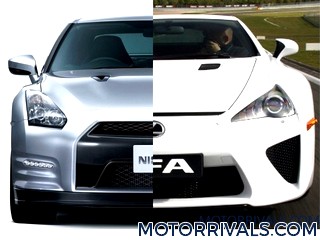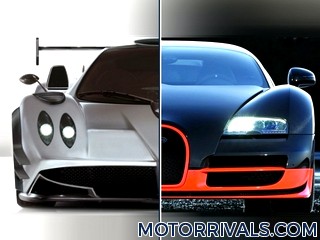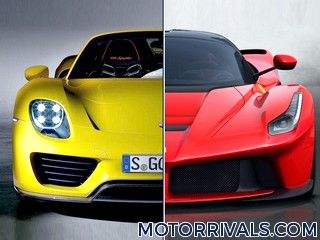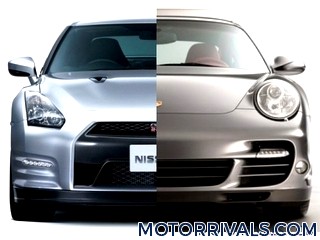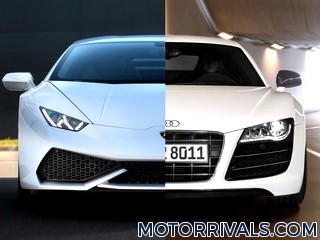2012 Nissan GT-R vs 2011 Lexus LFA
The Lexus LFA arrives to dethrone the GT-R as the king of Japanese supercars. Many of you might think this comparison isn't fair. In a lot of ways it isn't depending on how you look at it. The $375,000+ price tag of the LFA is more than four times the price tag of the GT-R. An array of gizmos is included but more importantly, performance technology. A wide use of new carbon fiber and new weaving techniques matched with a powerful V10 engine puts it in an elite league of supercars. For all that money and all that technology though, it still can't dominate a GT-R.
Although both cars have different styling themes, both look distinctively Japanese. They're not sleek and sexy like their Italian rivals but edgy with a technological feel, something styled more for the video game generation. The LFA has a lower front end fitted with large air openings and has a drag coefficient (Cd) of 0.31. The LFA's horizontal headlights and low front end give it a wider appearance than the GT-R.
Nissan put the GT-R's upper and lower grille front and center unlike the LFA's wide split air intakes. The black bar splitting the grilles isn't exactly the most elegant design but that's not what Nissan was going for. The front end isn't as low as the LFA but Nissan says they wanted a "chunky, edgy, wide shouldered" body. I'd say mission accomplished. Even with a chunkier front end, the GT-R manages a Cd of 0.27 beating the LFA and numerous other supercars.
The LFA trades in aluminum for Carbon Fiber Reinforced Plastic (CFRP) in the chassis. A Biggest Loser-worthy 221 pounds were lost in the process with 65 percent of the body structure being carbon fiber which is four times stronger than aluminum. The wheels are exquisite and better than the relatively generic looking GT-R's wheels.
The LFA is smaller and much lighter than the GT-R. The LFA is over 500 pounds lighter and over 5 inches shorter. It's really a mystery as to why the LFA can't achieve better performance numbers than it does considering a superior power-to-weight ratio. The GT-R however, benefits from more torque, the fantastic ATTESA E-TS all-wheel drive system, and sticky Dunlop tires that also help it achieve one of the best production Nürburgring lap times of 7:26.7 mins. The production version of the LFA hasn't been officially lapped yet but Auto Express reported an unofficial lap time of 7:24 mins for the concept version (you have to take that number with a grain of salt though).
The six inch difference in height (the LFA is shorter) is substantial between the two supercars. The LFA's roofline takes a smoother shape from front to back. The side air scoops are a nice touch with the upper scoop being distinctively unique. The door mirrors are actually designed to channel air into it.
Nissan designers actually said they didn't want "a nice elegant shape" for the GT-R. They wanted "an original shape" which is achieved with the blacked out A-pillar and kinked C-pillar that also helps rear airflow. The front fender vent also helps in aerodynamics and cooling the engine. The GT-R isn't as exotic as the LFA but it'll still get its fair share of attention and admiration.
The massive rear grilles of the LFA are another distinctive look which the LFA pulls off well. It's not the sexiest design but adds a bit of muscular flair. They're nicely integrated with a visual connection with the taillights which are a sharp, clean design. The GT-R's lights pay homage to its predecessors and are arguably the best looking taillights yet of any Skyline models.
Carbon fiber is used for the LFA's rear diffuser that places the stacked triple exhaust in the center. The exhaust design is a bit over the top and probably would've looked just as good or better with the dual twin-exhaust pipe layout of the GT-R. The LFA's active rear wing is a bit short in width but still nicely proportioned with the rear window. It deploys at 50 mph to help improve downforce and handling. The GT-R's static rear spoiler has more of a sport-tuner look as do the gigantic exhaust pipes that are nearly as large as the taillights.
The price difference is most notable in the interiors. The LFA gets premium quality materials that the GT-R is no match for. The cabin is hand-built with a nicer, more modern layout and filled with technological enhancements. The instrument panel is an LCD display that changes appearance depending on which mode you're in and also glows red when you approach the 9,000 rpm redline. It includes a lap timer next to a digital tachometer which is required instead of an analog one because an analog tach would be too slow for the fast revving engine. The screen is controlled by a button on the flat-bottom steering wheel which also houses the engine start/stop button.
Another screen is placed in the center console which is controlled by Lexus' Remote Touch joystick system which is being regarded as one of the best in the industry. The seats are upholstered in leather and Alcantara and matched with seatbelt airbags that inflate in the event of a crash. The interior is customizable with various colors like the exterior which has an available 30 different colors to choose from. Carbon fiber is also used throughout the interior to compliment the exterior.
The GT-R's interior isn't quite as upscale but still has its fair share of technology. The creators of Gran Turismo were actually involved in developing the customizable multifunction center screen. It gives drivers information overload including numerous temperatures and pressures, longitudinal and lateral G-force, and much, much more. It can even be used to improve driving technique making it not just a car, but a driving professor.



